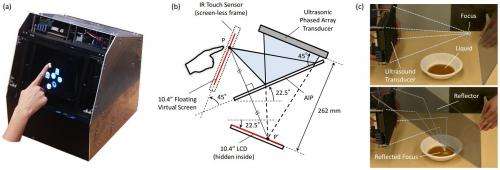HaptoMime offers mid-air interaction system (w/ Video) (original) (raw)

HaptoMime enables interaction with floating images in the presence of ultrasonic tactile feedback. (a) System appearance. (b) System configuration. (c) Redirection of an acoustic radiation pressure by ultrasonic reflection. Credit: Proceedings of the 27th annual ACM symposium on User interface software and technology, 2014
HaptoMime gives the word "touchscreen" a new meaning—one that will need to be carefully reworded, as HaptoMime involves a screen that you cannot touch. All the same, it enables interaction with floating images in the presence of ultrasonic tactile feedback. The proposed HaptoMime mid-air interaction system consists of four key components, the Aerial Imaging Plate, a liquid crystal display, an infrared touch sensor, and an ultrasonic phased array transducer.
"The dream of interacting with mid-air projected 3D images has fascinated people and driven a variety of relevant researches thus far," said the researchers behind HaptoMime, and they prepared a paper on their work for the Proceedings of the 27th annual ACM symposium on user interface software and technology, which took place in Hawaii earlier this month. The paper is titled, "HaptoMime: Mid-Air Haptic Interaction with a Floating Virtual Screen." The authors are from the Graduate School of Frontier Science, University of Tokyo. In fundamental terms, James Plafke, writing in ExtremeTech, said that the HaptoMime display projects holographic images into the air with the help of reflective surfaces, creating what appears to be floating images. Lakshmi Sandhana in New Scientist also said it used reflective surfaces to create a holographic display. "Now thin air can be a touchscreen. Plafke made the point that "What makes HaptoMime unique is not that the touch display is holographic, but that you can actually feel what you're touching."
The authors wrote, "We have created a device which enables us to interact with a floating touchscreen. Users feel vibrotactile stimuli on the fingertip by focused ultrasound when they touch floating objects." As Plafke wrote in ExtremeTech, "The physical sensation of touch—i.e., haptic feedback—is achieved through ultrasonic vibrations, and changing the ultrasonic pressure will create different sensations." The authors further discussed their approach: "Floating images formed by tailored light beams are inherently lacking in tactile feedback. Here we propose a method to superpose hands-free tactile feedback on such a floating image using ultrasound. By tracking a fingertip with an electronically steerable ultrasonic beam, the fingertip encounters a mechanical force consistent with the floating image."
HaptoMime: Mid-air haptic interaction with a floating virtual screen
The authors talked about their proposed transmission scheme and discussed applications for their approach. The technology, they said, would free up users to enjoy web-browsing even when their hands were wet or dirty. In instances of a public risk of contagion, it would be an alternative to multiple, unidentified users having to share a touchscreen. Furthermore, secure key input could benefit from their approach, due to the fact there remains no fingerprint on a virtual screen. The tactile feedback could support rhythmical key input in mid-air by physically indicating the end of a touch stroke. The system could be used to enter passwords, as for an ATM procedure, or to play that virtual piano. The system was controlled by a Windows 7 computer running on AMD E-450 APU (1.65 GHz).
HaptoMime: Mid-Air Haptic Interaction with a Floating Virtual Screen
More information: HaptoMime: mid-air haptic interaction with a floating virtual screen, Proceedings of the 27th annual ACM symposium on User interface software and technology, 2014. dl.acm.org/citation.cfm?id=2647407
© 2014 Tech Xplore
Citation: HaptoMime offers mid-air interaction system (w/ Video) (2014, October 29) retrieved 19 November 2024 from https://techxplore.com/news/2014-10-haptomime-mid-air-interaction-video.html
This document is subject to copyright. Apart from any fair dealing for the purpose of private study or research, no part may be reproduced without the written permission. The content is provided for information purposes only.